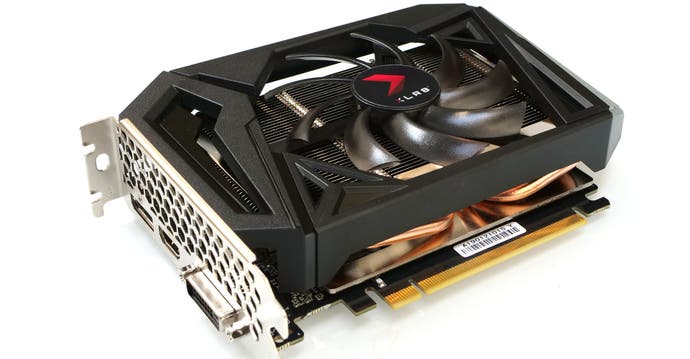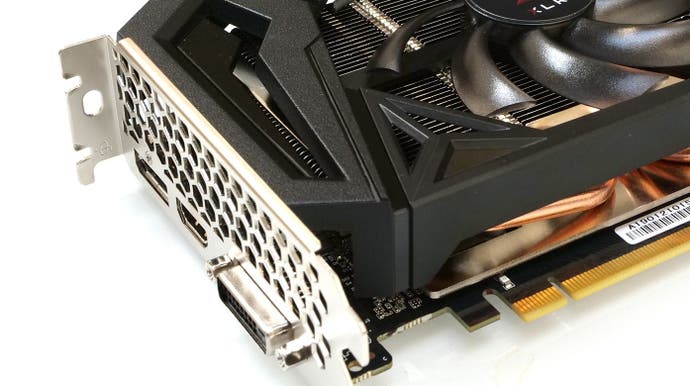GTX 1660 Ti benchmarks: Digital Foundry's 1080p, 1440p and 4K results
Nvidia's first non-RTX Turing card tested.
The GTX 1660 Ti seems to be what many in the gaming community have been asking for: an affordable Nvidia graphics card that leaves out real-time ray tracing and DLSS but still delivers the increased performance of the Turing architecture. In essence, the new GPU should offer performance between the GTX 1070 and RTX 2060, at a lower price than both: £259 in the UK and $279 in the US. In this article, we'll show you exactly what sort of frame-rates you should expect in a selection of recent titles.
Before we get into the results, let's briefly cover what you get with the GTX 1660 Ti over the GTX 1060 beyond an uptick in raw performance. While the lack of RT and Tensor cores mean that RTX and DLSS are off the table, other Turing features that don't rely on this dedicated hardware have made it in. Specifically, new shader models should allow for increased performance in games that support them, such as Variable Rate Shading in Wolfenstein 2: The New Colossus. This means that the card will be a little more future-proof than its Pascal predecessors, even if full-fat RTX cards are likely to remain relevant for longer.
The GTX 1660 Ti is also an efficient card, with a modest 120W TDP that compares favourably to the 150W GTX 1070 and 175W RX 590. This also allows for very compact card designs, such as PNY XLR8 card we used for testing. This is a single-fan design that requires only one eight-pin PCI power input, yet it still includes a modest 45MHz overclock over the reference specification which should add around one per cent to our frame-rates.
We will test the card against the previous-gen GTX 1060 and GTX 1070, plus the new RTX 2060. We'll also include competition from AMD, in the form of the RX 580, RX 590 and Vega 56. While our GTX 1660 Ti review concentrates on 1080p and 1440p, the resolutions that this card is best at, we're also including 4K results here for the sake of completeness. Don't expect brilliant results at this resolution, but if you're willing to turn down enough settings you should be able to at least attain a console-quality 30fps experience if that's your preference.

| GPU cores | VRAM | Memory Bus | Bandwidth | Boost Clock | TDP | |
|---|---|---|---|---|---|---|
| GTX 1060 | 1280 | 6GB GDDR5 | 192-bit | 192GB/s | 1708MHz | 120W |
| GTX 1070 | 1920 | 8GB GDDR6 | 256-bit | 256GB/s | 1683MHz | 150W |
| GTX 1660 Ti | 1536 | 6GB GDDR6 | 192-bit | 288GB/s | 1770MHz | 120W |
| RTX 2060 | 1920 | 6GB GDDR6 | 192-bit | 336GB/s | 1680MHz | 160W |
| RX 580 | 2304 | 8GB GDDR5 | 256-bit | 256GB/s | 1340MHz | 185W |
| RX 590 | 2304 | 8GB GDDR5 | 256-bit | 256GB/s | 1545MHz | 175W |
| RX Vega 56 | 3584 | 8GB HBM2 | 2048-bit | 410GB/s | 1474MHz | 210W |
If you're new to Digital Foundry, you might not have seen our unique system for showing benchmark results. The idea is that instead of using static graphs or burned-in video data, we're combining the two into a dynamic system. Press play on the YouTube video embedded for each game we tested, and you'll see live telemetry for frame-times and frame-rates that gives you a better idea of performance than a simple average. You can choose which cards at which resolutions you want to see with the controls to the right of the video, with up to four data sources being shown at once.
If you're in a rush, you can also find average frame-rate figures in a barchart below. Here, you can also mouse over the chart to see how each card did at the best or worst moments of the benchmark, which can tell a different stories than the averages alone. Click on the resolution tabs to the right to see results for 1080p, 1440p and 4K. You can also click on the chart to change between frame-rate values and percentages, which can make it easier to compare two results without the need for mental gymnastics. Now, let's get into the results!
Assassin's Creed Odyssey
The most recent Assassin's Creed release offers a substantial challenge for modern GPUs, thanks to its detailed texture work and open world. The benchmark is a nice representation, despite the disquieting shouts of the guards as the camera moves past them in the opening seconds. The GTX 1660 Ti lies between the GTX 1070 and RTX 2060 here, although it's a hair closer to the former than the latter. The 54fps average at 1080p is just a few settings tweaks away from a solid 60fps - and remember, we're using the challenging ultra high preset here. 1440p is also quite playable, with an average of 41fps. On the AMD side of things, there's a significant gap between the 30fps 1440p average of the RX 590 and the 57fps average of the Vega 56.
AC Odyssey: Ultra High, TAA
Assassin's Creed Unity
Assassin's Creed Unity, the 2014 release, uses a depth-of-field effect that remains challenging to this day - especially on AMD hardware. The GTX 1660 Ti falls behind the GTX 1070 in this older title, although the one or two fps difference isn't likely to be perceptible. The game is playable on ultra high with FXAA on the GTX 1660 Ti, with an 82fps average at 1080p and a 52fps average at 1440p. The GTX 1660 Ti manages to exceed even the Vega 56 here, although as we mentioned earlier it's not really a fair fight - or a more widely representative trouncing - for Team Red.
Assassin's Creed Unity: Ultra High, FXAA
Battlefield 1
EA's modern Frostbite engine delivers excellent performance on new hardware, and that trend continues with the GTX 1660 Ti. The card manages a straightforward 11 per cent leap over the GTX 1070 at 1080p, although this drops to five per cent at 1440p. While AMD cards also handle Frostbite games well, the GTX 1660 Ti heavily outperforms the RX 590 with a 15 per cent lead at 1440p.
Battlefield 1: Ultra, TAA
Crysis 3
2013 release Crysis 3 is the oldest game in our tests, but for anyone that knows the series it's not surprising that it remains one of the most challenging - especially for newer GPUs that can't use new tricks to raise their performance. Our explosive-laden train ride brings the GTX 1660 Ti to around 104fps at 1080p, which is seven fps behind the GTX 1070. The GTX 1070 is further ahead at 1440p, although the new Nvidia card still manages to exceed the 60fps threshold.
Crysis 3: Very High, SMAA T2X
Far Cry 5
The relaxing ambience of the Far Cry 5 benchmark conceals a pretty difficult rendering challenge, with a big open-world environment and some punishing scenes. The GTX 1660 Ti comes close to the GTX 1070 here in terms of average frame-rate, but dips lower in the most challenging sections on the benchmark. Still, even the dips don't bring us below 60fps at 1080p, making for a very playable experience. That's not strictly true at 1440p, where we do see dips to around 58fps, but even then it is a pretty strong result for a card at this price point.
Far Cry 5: Ultra, TAA
Ghost Recon Wildlands
TCGRW is the most challenging game in our current suite, despite being released almost two years ago - the ultra preset included in this game is just that punishing. The GTX 1660 Ti shows better performance here, moving past the GTX 1070 by a hair at 1080p and 1440p. However, the new card does fall behind the GTX 1070 marginally at 4K, with a sub-30fps result.
Ghost Recon Wildlands: Ultra, TAA
Rise of the Tomb Raider
Rise of the Tomb Raider comes next. Here, the GTX 1070 leads the 1660 Ti by two per cent at 1080p and five per cent at 1440p. Again, we see that the balance of power shift, with older games like this offering fewer shortcuts that newer cards can take advantage of to improve their performance. Still, the difference between the two cards is slight, within the range of minor settings tweaks or overclocking, so it isn't too impactful.
Rise of the Tomb Raider: Very High, SMAA
Shadow of the Tomb Raider
Shadow of the Tomb Raider, the 2018 release and the end of the remake trilogy, is our next test. The GTX 1660 Ti performs better here, pulling ahead of the GTX 1070 by around five per cent at each of the resolutions we tested at. Compared to the GTX 1060, there's an even larger advantage for the new card: 47 per cent at 1080p and 30 per cent at 1440p. That's a convincing generational improvement.
Shadow of the Tomb Raider: Highest, TAA
The Witcher 3
We conclude with another legacy title, The Witcher 3. The GTX 1060 was outperformed by the RX 580 and RX 590 here, but the GTX 1660 Ti is much more competitive. We're looking at a 35 per cent boost for the new GPU over its predecessor at 1080p, which ends up being faster than the RX 580 and RX 590 but slower than the Vega 56.
Witcher 3: Ultra, Post-AA, No Hairworks
So, that's the kind of performance you can expect from the GTX 1660 Ti: about 10 per cent faster than the GTX 1070 in modern games, but a little slower in some legacy titles. For more on what makes this new mainstream GPU tick, read the full Digital Foundry GTX 1660 Ti review.
Now that you've seen the benchmarks for one card, why not check out see which PC hardware we recommend to our friends and family? Here are the DF picks for the overall best graphics cards and for the best gaming monitors on the market.

